Whether you're organizing quick one-on-one meetings or lively group-based sessions, this guide will walk you through how to set up your rotation smoothly — with or without a participant list in hand.
We’ll cover simple formats you can launch right away, explore how technology can take care of the more complex parts, and show you how to make sure everyone knows exactly where to sit and when. If you're aiming for a seamless experience (without spending hours in spreadsheets), you’re in the right place.
One-on-One or Group Sessions?
Before we dive into the logistics, let’s assume you already have a general idea of how speed networking works: quick, timed conversations designed to spark meaningful connections.
If you're planning one-on-one conversations, the classic speed dating rotation might be all you need. One row stays seated, the other moves one seat over after each round. Simple, effective, and great for small to medium groups.
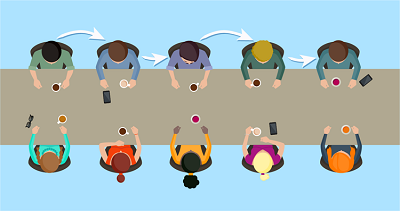
It doesn’t even have to be a long table. You can number individual chairs or small tables and rotate people between them.
But as you can probably tell, this speed networking template has its limits. Will everyone get to meet everyone? Not quite. Just like in traditional speed dating, one side only meets the other. If your goal is full coverage or more advanced matching, this format starts to fall short.
And what if you’re planning group-based sessions, with several people per table? That’s a whole different story — and not something you want to figure out with pen and paper.
Already Have a Participant List, or Looking for a Way to Collect Signups?
If you're handling registration using your own tools — or you simply have a participant list by the time the event gets closer — you’ll likely end up with a spreadsheet. Names, contact info, and possibly some preferences: who should meet whom, or who must not. Perfect. Just import that file into the tool you're using to build your rotation.
Some platforms (like MixerSeater) let you upload your list directly, and even manually add last-minute signups or remove cancellations without breaking the flow. Need on-site check-in? That’s covered, too.
But if you don’t have a list yet, or you want to streamline the whole process, there’s another way. The platforms include a built-in registration form — simple, customizable, and connected straight to the rotation builder. That means no exporting, no importing — attendees register themselves, add their preferences, and they’re instantly added.
Need something more advanced? If your registration form includes multiple questions, complex logic, or you’d like to sell tickets at the same time, some platforms offer API integration. You can request a custom landing page for your event — complete with payment processing and a fully tailored registration flow. All signups feed directly into your admin dashboard, so you can keep track of everything in one place.
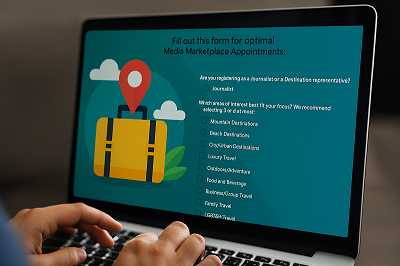
Now You’ve Got the Names. Let’s Create the Rotation Schedule
If you’ve been working from a spreadsheet — no problem. Just import it into the speed networking rotation generator. It’ll recognize your column headers automatically. You can include participant preferences, mark who’s a VIP or a table moderator (so they stay seated), and define any special conditions.
By the way — VIPs will always have the fewest duplicated meetings, if any. They’re VIPs for a reason!
If your registrations went directly into the system, you can skip the import step altogether. All participant data, including preferences and constraints (like “people from the same company shouldn’t meet”), is already there and ready to go.
Now for the magic: enter the number of tables, the number of seats per table, and how many rounds you'd like to run. Behind the scenes, the system will analyze millions of possible rotations to find the best possible seating chart — usually in under a minute.
And if you want to tweak something afterward? No problem. You can always make manual adjustments before finalizing the setup.
How Will Participants Know Where to Sit?
If you're running a classic speed dating–style event, it’s easy — just point people to the next seat. Everyone moves one spot over each round, and you’re good to go.
But for more advanced formats, especially group-based rotations or one-on-one sessions with complex rules, you’ll want a more structured way to guide participants. Here are a few options:
Print a Seating Plan
A simple printout showing who goes to which table in each round. Stick it on a wall or hand out copies. Great for small events or venues with good signage.
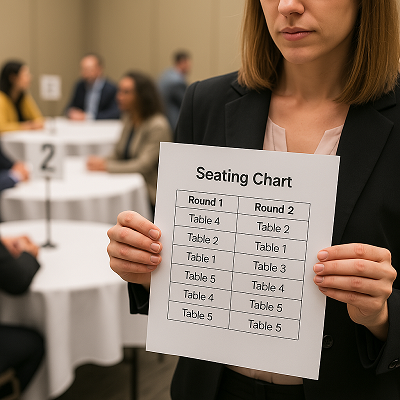
Badges / Individual Agendas
Give each participant a personalized schedule — including which table to go to, who they’ll meet, and even what time each meeting starts. You can optionally include short bios or company info to help spark conversations.
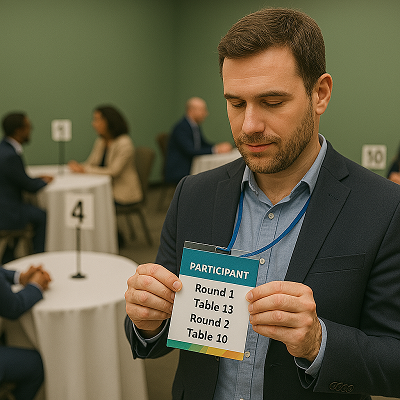
Email the Agendas in Advance
You can send everyone their meeting agenda before the event — helpful if you want people to come prepared. Just keep in mind: if a lot of attendees drop out last-minute, printed or emailed plans may become outdated.
Mobile-Friendly, No App Needed
Let participants view their agenda live on their phones — no need to download anything. Right before the event starts, you can check who’s actually in the room and regenerate the seating chart accordingly. Since the agenda is web-based, everyone gets real-time updates. No one ends up sitting alone, and the whole flow stays smooth.
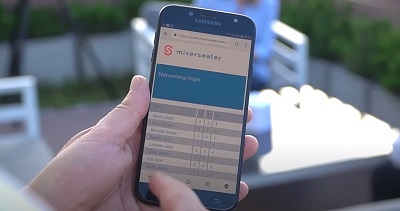
Too Busy to Set It Up? We’ll Handle It All
Building a great networking experience takes time — collecting registrations, importing spreadsheets, setting up rules about who should (or shouldn’t) meet, calculating the ideal number of rounds, checking for duplicates… and learning how to use yet another new tool.
Or — you can let us take care of it! We run hundreds of these events. From small team mixers to high-stakes investor meetings and even fairs, we’ll set everything up remotely and make sure it runs smoothly.
Tell us what you need — we’ll take it from there. Pricing starts at $499 per event.